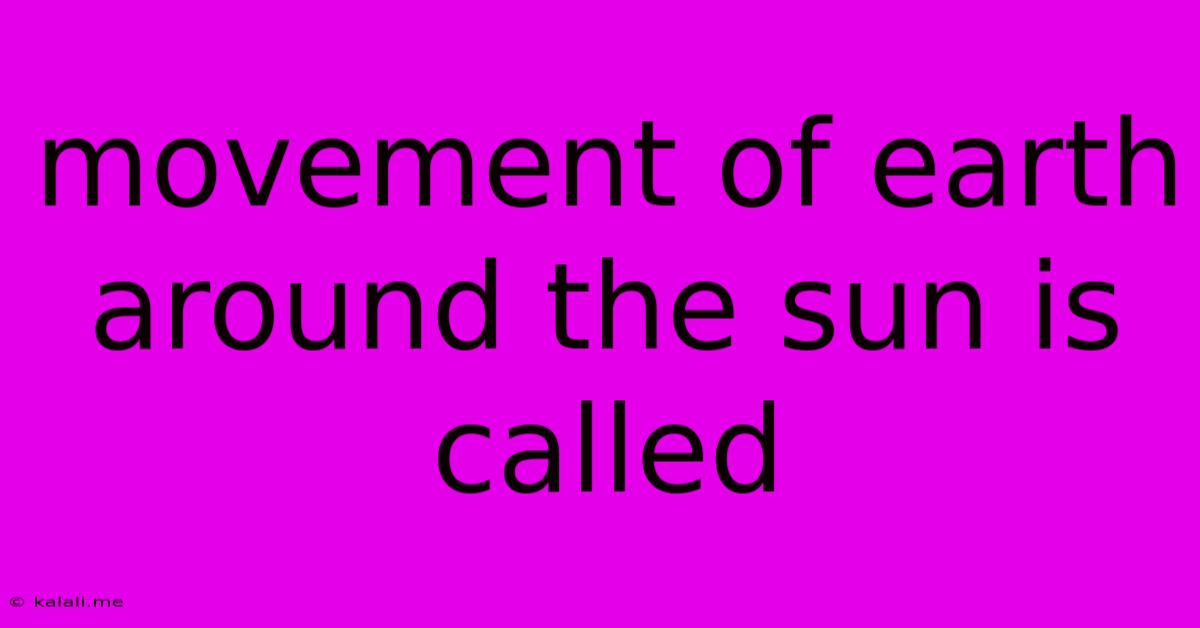Movement Of Earth Around The Sun Is Called
Kalali
Jun 14, 2025 · 3 min read

Table of Contents
The Movement of Earth Around the Sun: Understanding Revolution and its Effects
The movement of Earth around the Sun is called revolution. This continuous journey, taking approximately 365.25 days, is responsible for the changing seasons and the length of our year. Understanding Earth's revolution is crucial to grasping fundamental concepts in astronomy and appreciating the intricacies of our planet's relationship with its star. This article delves into the details of Earth's revolution, exploring its mechanics, effects, and related astronomical phenomena.
What is Revolution?
Revolution, in the astronomical context, refers to the orbital motion of a celestial body around another, more massive body. In the case of Earth, this means its orbit around the Sun. Unlike rotation (the spinning of Earth on its axis, causing day and night), revolution is a much larger-scale movement, defining the length of a year and influencing numerous aspects of life on Earth. The path Earth takes around the sun is not a perfect circle, but rather an ellipse – a slightly elongated oval.
Factors Influencing Earth's Revolution
Several factors influence the Earth's revolutionary journey:
- Gravity: The Sun's immense gravitational pull is the primary force keeping Earth in its orbit. This attraction prevents Earth from flying off into space, maintaining a relatively stable distance.
- Inertia: Earth's own inertia, its tendency to resist changes in motion, contributes to its continued movement around the sun. This momentum counteracts the inward pull of gravity, preventing a direct collision.
- Orbital Velocity: The speed at which Earth travels in its orbit is not constant. It moves faster when closer to the Sun and slower when further away, a consequence of Kepler's Laws of Planetary Motion.
Effects of Earth's Revolution
The revolution of Earth around the Sun has profound effects on our planet:
- Seasons: The Earth's tilt on its axis (approximately 23.5 degrees) combined with its revolution creates the seasons. As Earth orbits the Sun, different hemispheres receive more direct sunlight, leading to warmer temperatures (summer) and less direct sunlight, resulting in cooler temperatures (winter). The equinoxes mark the transition points between seasons, where both hemispheres receive roughly equal sunlight.
- Year Length: The time it takes for Earth to complete one revolution around the Sun defines our calendar year – approximately 365.25 days. The extra quarter-day necessitates the addition of a leap day every four years to keep our calendar synchronized with the Earth's orbital period.
- Aphelion and Perihelion: Earth's elliptical orbit means its distance from the Sun varies throughout the year. Aphelion is the point in Earth's orbit where it is farthest from the Sun, while perihelion is the point where it is closest. These variations in distance have a minor influence on seasonal temperatures.
Understanding Orbital Mechanics
The study of Earth's revolution involves understanding fundamental principles of orbital mechanics, including Kepler's Laws, which describe the motion of planets around the Sun. These laws help us predict the Earth's position and velocity at any given point in its orbit. The understanding of these laws played a crucial role in advancements in astronomy and space exploration.
Conclusion
The movement of Earth around the Sun, known as revolution, is a fundamental process shaping our planet's environment and the experience of life on Earth. From the changing seasons to the length of our year, understanding this orbital journey provides insights into the vastness of space and the delicate balance that sustains life on our planet. Further exploration into related concepts like Kepler's Laws and celestial mechanics will deepen your understanding of this crucial astronomical phenomenon.
Latest Posts
Latest Posts
-
Approximately How Many Elements Occur Naturally On Earth
Jun 15, 2025
-
What Is 10101010 In Decimal Format
Jun 15, 2025
-
Common Multiple Of 28 And 98
Jun 15, 2025
-
Which Of The Following Is Not True Of Organelles
Jun 15, 2025
-
Oxidation State Of C In Ch4
Jun 15, 2025
Related Post
Thank you for visiting our website which covers about Movement Of Earth Around The Sun Is Called . We hope the information provided has been useful to you. Feel free to contact us if you have any questions or need further assistance. See you next time and don't miss to bookmark.